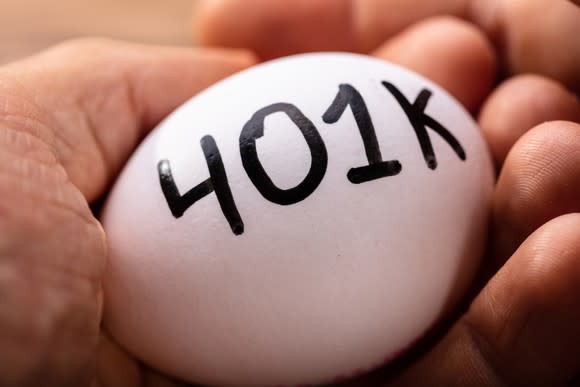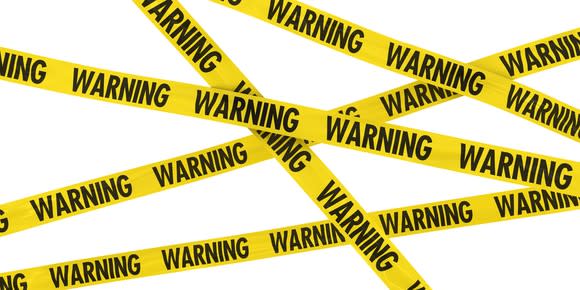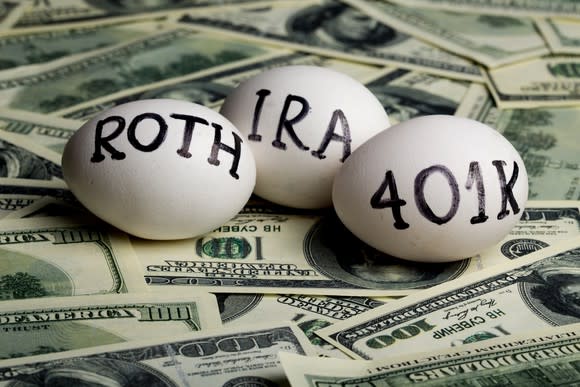The Top 12 401(k) Mistakes to Avoid
If you're like most Americans, you need to do a lot of saving and investing if you want to enjoy a comfortable retirement. Unless you have a hefty pension or a big inheritance coming your way, it's largely up to you to ensure your future financial security.
A 401(k) account can be a surprisingly powerful tool for retirement saving -- but not if you make some common 401(k) mistakes. Here's an introduction to what 401(k) accounts are, what they can do for you, and how to make the most of them while avoiding a dozen costly blunders.

Image source: Getty Images.
What's a 401(k)?
In 1980, the primary retirement plan for 30% of all private-sector workers was a "defined benefit" plan, i.e., a traditional pension, according to the Employee Benefit Research Institute. The Bureau of Labor Statistics reports that as of March 2018, while 48% of private establishments offered retirement plans to workers, only 8% offered defined benefit plans. Instead, nearly half of establishments (47%) offered "defined contribution" plans -- typically in the form of 401(k) plans.
The 401(k) plan gets its name from the section of the Revenue Act of 1978 in which it was introduced. It's referred to as a "defined contribution" plan because 401(k)s are funded by fixed sums of money (such as 8% of salary) contributed regularly by employees (and often their employers, too). The ultimate value of the account is uncertain, as it depends on how long the money has to grow and how quickly it grows. Meanwhile, "defined benefit" plans are exemplified by traditional pensions, with few people knowing exactly what goes into them but employees and retirees having a good idea of how much they will get out of their pensions in retirement benefits.
401(k) plans have become very prevalent in workplaces. As of late June 2018, about 55 million employees and millions of former employees and retirees had more than $5 trillion socked away in them -- fully 19% of the total retirement assets in America, per the Investment Company Institute.
The power of a 401(k) account for retirement savings
Income from 401(k) accounts has been estimated to represent about 25% to 30% of overall retirement income. That won't be surprising if you appreciate just how much money you can amass with a 401(k) account -- in part due to the hefty annual contribution limits. The 2019 limit is $19,000, plus an additional $6,000 if you're 50 or older, for a possible total of $25,000.
Sure, diverting $19,000 or $25,000 of each year's pay into a 401(k) account isn't possible for many workers, but the more you're able to save, the bigger a nest egg you can amass. The table below shows how effective it is to make big annual contributions and to do so for as many years as possible.
Years of 8% Growth | Balance if Investing $5,000/Year | Balance if Investing $10,000/Year | Balance if Investing $15,000/Year |
|---|---|---|---|
15 years | $146,621 | $293,243 | $439,864 |
20 years | $247,115 | $494,229 | $741,344 |
25 years | $394,772 | $789,544 | $1.2 million |
30 years | $611,729 | $1.2 million | $1.8 million |
Calculations by author.
If you think it's supremely unlikely that you'll ever have $1 million in your account, think again. Fidelity Investments, which helps some 23,000 businesses administer their employee benefit programs, including 401(k) plans, reported a record number of 401(k) accounts with balances of $1 million or more in the first quarter of 2018: 157,000, up 45% from 108,000 in the previous year. (It also noted that most of those folks had been saving for around 30 years.)
Clearly, those who regularly save money over many years can amass substantial nest eggs for retirement. Now let's take a look at what can go wrong if you make one of these 401(k) mistakes.

Image source: Getty Images.
401(k) mistakes that can cost you a lot
There are lots of mistakes one can make with retirement accounts such as 401(k)s, and the more of them you make, the more money you'll likely leave on the table. Take some time to learn what not to do and make smart moves with your 401(k) account. You may end up surprised by how much wealth you can build.
Here are 12 common 401(k) mistakes:
Not participating in your 401(k) plan
Not contributing enough to your 401(k)
Not increasing your 401(k) contributions regularly
Not contributing enough to get the full employer 401(k) match
Loading up on too much company stock
Staying with your 401(k) plan's default investment choices
Picking the wrong mutual funds and investments
Ignoring fees in your 401(k)
Not considering the Roth 401(k)
Ignoring important 401(k) rules
Cashing out or borrowing from your 401(k)
Not appreciating the downsides of 401(k)s
Mistake No. 1: Not participating in your 401(k) plan
The biggest mistake you can make regarding your 401(k) plan is not participating in the first place. The Plan Sponsor Society of America found that in 2016, 85% of eligible employees contributed to 401(k) plans. That's quite good, but it also means that 15% did not. Unless those people have some other solid income streams in store for them in the future, they're leaving their retirements at risk.
If you're not participating in your employer's plan because you know you've already lined up sufficient retirement income, perhaps through a pension, then that's fine. But if you're just putting it off or don't think participating is really worth it, you're putting your future financial security at risk. Consider that 1) it's typically easy to participate and 2) a 401(k) plan can help you amass hundreds of thousands of dollars for retirement -- with some tax breaks thrown in as well. Putting off investing for retirement for just one year might even cost you $100,000 or more.
Even if you're still very young, don't assume you can put off investing because retirement is still so far away. Remember: Even if you're only 30 and think you're 35 years away from retirement, any money you invest now will have 35 years to grow. That's powerful. Look at the table below, which shows how much each thousand dollars you invest might grow to over various periods:
Years of 8% Growth | Final Value of $1,000 Investment |
|---|---|
5 years | $1,469 |
10 years | $2,159 |
15 years | $3,172 |
20 years | $4,661 |
25 years | $6,848 |
30 years | $10,063 |
35 years | $14,785 |
40 years | $21,725 |
Calculations by author.
Note how much a single $1,000 can grow to if it has 10 years to grow versus 40 years. You can amass more than 10 times as much money if your money has four times longer to grow. Notice, too, that between each five-year period, the amount by which the total changes also grows. The difference between years five and 10 is only $690, but the difference between years 30 and 35 is a whopping $4,722. The lesson is clear: Start early and invest aggressively, because your earliest-invested dollars can grow the most.
Mistake No. 2: Not contributing enough to your 401(k)
Another blunder often becomes clear only in retrospect: Not contributing as much as you could have to your account. When the folks at Schwab recently conducted a survey of 1,000 participants in the 401(k) accounts they administer, they found many regretting that they hadn't spent less in order to have saved more. Here are the top spending regrets:
55% regretted not spending less on meals out
31% regretted not spending less on expensive clothes
28% regretted not spending less on new cars
28% regretted not spending less on vacations
26% regretted not spending less on newest tech gadgets
Take a few minutes to ask yourself whether you could contribute more to your 401(k) than you're contributing now.

Image source: Getty Images.
Mistake No. 3: Not increasing your 401(k) contributions regularly
Even if you think you're contributing enough to your 401(k) every year, you should aim to save more every year -- or at least until you're socking away as much as you need to, which could be as much as 15% or 20% of your income.
The folks at Fidelity ran the numbers for an imaginary 25-year-old who starts out earning $40,000 annually and saves annually until retirement at age 67. The eye-opening results below show the power of making modest increases to your contributions, expressed in both monthly and annual terms:
Increase | Change in Monthly Income in Retirement | Change in Annual Income in Retirement |
|---|---|---|
One-time 1% increase | $190 more per month in retirement | $2,280 more per year |
1% increase every 5 years for 25 years | $690 more per month in retirement | $8,280 more per year |
1% increase every year for 12 years | $1,930 | $23,160 more per year |
Source: Fidelity.com.
Most of us could probably use an additional $1,930 (or however much you end up with) each month in retirement.
Mistake No. 4: Not contributing enough to get full employer 401(k) match
Another mistake you might make, especially if you're not contributing a lot to your 401(k), is not taking full advantage of an employer match. Most 401(k) plans come with a match. In one common type of employer match, the employer contributes 50% of your contributions of up to 6% of your salary. So if you earn $70,000 and contribute 6%, or $4,200, your employer will add another $2,100. That's $2,100 of free money and a guaranteed 50% return on your investment, which you'd be hard-pressed to find anywhere else.
Some good news in the 401(k) world is that matches have been rising recently, hitting a median of 4% in 2016, per a Vanguard report, up from 3.5% in 2014 and 3% in 2007. There are some companies with much bigger matches, though, so don't assume that 4% or 5% is top-notch. Some workers receive 6% to 10% from their companies, though such contributions are far from the norm.
Mistake No. 5: Loading up on too much company stock
Another blunder is stuffing your 401(k) with too much of your employer's stock. Yes, you may know your employer far better than you know any other company, and that gives you an edge as an investor. But there's risk, too. Consider, for instance, that you already get most or all of your income from your employer. If you also have most of your retirement money invested in your employer, too, then you have a heck of a lot of eggs in one basket. If the company runs into trouble, then not only your job may be in jeopardy, but your retirement, too.
Remember that plenty of workers have been blindsided when their employers' fortunes changed. Think of Enron and other companies where employee retirement savings took big hits or completely imploded. In April, The Wall Street Journal profiled a General Electric retiree who had some $280,000 in company stock upon retiring but watched his shares' value plummet to $110,000. Since April, GE shares have dropped further -- roughly 30% as of this writing.
Consider having no more than 5% or 10% of your overall retirement savings in your employer's stock.
Mistake No. 6: Staying with your 401(k) plan's default investment choices
It's also a big mistake to be too conservative in the way you invest your money -- especially if you're young. You may be plowing huge sums into your 401(k) every year, but if your money s growing much more slowly than it could, you'll be losing out on a lot of gains.
A common way that people unknowing invest their money too conservatively is if they don't actively select investments and instead just leave fund in their plan's default investments, which are often very conservative. For most folks, especially the young, the stock market is the best choice for much or all of their money. Yes, it can be volatile, but over long periods it has always gone up. Check out the table below, featuring data from Wharton Business School professor Jeremy Siegel, who has calculated the average returns for stocks, bonds, bills, gold, and the dollar, between 1802 and 2012:
Asset Class | Annualized Nominal Return |
|---|---|
Stocks | 8.1% |
Bonds | 5.1% |
Bills | 4.2% |
Gold | 2.1% |
U.S. Dollar | 1.4% |
Source: Stocks for the Long Run
The next table shows what those rates of returns can do for you over time -- if you invest $10,000 annually over various periods and earn the various asset classes' average annual returns:
10 years | 20 years | 30 years | |
|---|---|---|---|
In Stocks at 8.1% | $157,345 | $500,201 | $1.2 million |
In Bonds at 5.1% | $132,812 | $351,219 | $710,383 |
In Bills at 4.2% | $126,270 | $316,806 | $604,318 |
In Gold at 2.1% | $112,309 | $250,561 | $420,750 |
In the U.S. Dollar at 1.4% | $108,033 | $232,179 | $374,843 |
Source: Author calculations.

Image source: Getty Images.
Mistake No. 7: Picking the wrong investments
It's easy to see why you should be invested in stocks (and perhaps have a portion of your portfolio in bonds for diversification). Because you can't pick individual stocks in your 401(k), you'll need to choose from the stock-focused mutual funds and/or exchange-traded funds (ETFs) that are on your plan's menu. And this presents another opportunity to make mistakes: If you're not careful, you may end up choosing funds that perform poorly.
You can research mutual funds at sites such as Morningstar.com, where you can look up funds' holdings, performance, and more. Be sure you understand the difference between actively managed and passively managed funds, too. An actively managed fund will have financial pros studying the chosen universe of stocks and carefully selecting investments for the fund according to its stated focus (which might be large companies, foreign companies, etc.). The managers will also be deciding when to buy and sell various investments -- and sometimes they do a lot more buying and selling than is ideal, resulting in a lot of commission costs and capital gains taxes.
Passively managed index funds, on the other hand, simply aim to mirror the performance of an index -- such as the S&P 500, which represents about 80% of the U.S. stock market -- by purchasing all the investments in that index, in the same proportions. So if you're invested in an index fund that tracks the S&P 500, your money will be spread across those 500 companies, and you'll enjoy roughly the same performance as the S&P 500.
While some actively managed funds do well, the vast majority don't do as well as passively managed index funds. Over the 15 years ending in June 2018, about 92% of U.S. large-cap stock mutual funds lagged the returns of the S&P 500. The pattern holds true for indexes of smaller companies, too. About 95% of U.S. mid-cap stock funds trailed the popular S&P MidCap 400 index over those 15 years, while the S&P SmallCap 600 index outperformed nearly 98% of all U.S. small-cap funds.
There are bond and real estate-focused index funds, too. Here are some candidates to consider:
SPDR S&P 500 ETF (NYSEMKT: SPY)
Vanguard Total Stock Market ETF (NYSEMKT: VTI)
Vanguard Total World Stock ETF (NYSEMKT: VT)
Vanguard Total Bond Market Index Fund (NASDAQMUTFUND: VBMFX)
Vanguard REIT Index Fund (NASDAQMUTFUND: VGSIX)
Mistake No. 8: Ignoring fees in your 401(k)
A key reason why index funds outperform so many managed mutual funds is their low fees. A typical actively managed stock mutual fund might carry an annual fee (known as the "expense ratio") of 1% or 1.5% or more, while many broad-market index funds sport annual fees of less than 0.25% or even 0.10%. That's often a difference of more than one whole percentage point.
Here's a look at how much of a difference a single percentage point can make. Imagine two identical mutual funds, one of which has an expense ratio of 1.1% and one of which charges only 0.1%. The table below shows how much annual investments of $10,000 would grow, assuming they averaged returns of 10% annually and then had those fees subtracted:
Investing Period | Balance Assuming 8.9% Growth | Balance Assuming 9.9% Growth |
|---|---|---|
10 years | $164,663 | $174,315 |
20 years | $550,920 | $622,348 |
30 years | $1.5 million | $1.8 million |
Calculations by author.
That seemingly small single percentage point can cost you tens of thousands of dollars over many years -- potentially even hundreds of thousands of dollars.
A 401(k) account can charge you other fees, too, on top of the fees charged by each fund or investment held in the account -- and few people realize it. A recent report from the folks at TD Ameritrade noted: "Just 27% know how much they're paying in fees on their 401(k) accounts. ... 401(k) plans aren't free; about 95% of 401(k) participants are paying administrative and other fees in addition to fund fees."
Larger companies tend to have lower 401(k) fees, while smaller companies tend to charge more. Anything above, say, 1% is worrisome, and some plans charge 2% or even 3% or more. Be sure to find out what kinds of fees you're being charged in your 401(k) and give extra consideration to choices with low fees. You may find the fees listed on your statements or in your plan's literature, and your human resources department should be able to tell you what they are as well.
You can also compare your employer's 401(k) with those of other companies at BrightScope.com. If your fees seem steep, let your company know. If they're downright outrageous, you may want to contribute just enough to max out any employer match and then do the rest of your retirement saving through IRAs -- accounts that offer similar tax breaks to a 401(k) -- and regular brokerage accounts.

Image source: Getty Images.
Mistake No. 9: Not considering the Roth 401(k)
More and more employers are now offering Roth 401(k)s, and it's a mistake not to investigate this option -- especially if you're still decades from retirement. With a traditional 401(k), you contribute your income before it's taxed, thereby reducing your tax bill for the year. When you withdraw the money in retirement, it's taxed as ordinary income to you. With the Roth 401(k), meanwhile, you contribute post-tax money and thus get no up-front tax break. However, you get a big tax break when you retire: If you follow the rules, you get to take all the money out of the account tax-free.
Imagine, for example, socking away $10,000 annually for 25 years and having it grow at an average rate of 8% per year. You'd end up with close to $790,000 -- and that would all be available to you in retirement, free of tax. Yes, you were taxed on that money, but every dollar you withdraw will be yours to keep. This is an especially big advantage if you expect your tax rate to be higher in retirement than it is now. Tax-free withdrawals also do away with any uncertainty regarding federal income tax rates: If you invest in a Roth 401(k), you don't need to worry about whether the government will later raise your tax rate and take a big bite out of your retirement savings.
Opting for a Roth 401(k) may be a smart decision, but there are circumstances in which a traditional 401(k) may be preferable. For example, if you expect your tax bracket in retirement to be significantly lower than your current one, you may want to shield some of your current income from your steep tax rate by contributing to traditional 401(k)s (and IRAs).
Mistake No. 10: Ignoring important 401(k) rules
Another blunder is not being aware of the various rules on 401(k) accounts. For example, you generally can't withdraw money from your 401(k) until age 59 1/2. Take money out before then, and you'll likely face a 10% early withdrawal penalty. There are some exceptions, though. If you leave your job in the year that you turn 55 or later, you can withdraw funds from that employer's 401(k) without penalty. Retiring early due to a qualifying disability can also free you from the penalty, as can a few other circumstances, such as financial hardship.
And if you're in no hurry to withdraw money, know that you can't delay doing so forever. A 401(k) account, whether traditional or Roth, comes with "required minimum distributions." An RMD is a certain amount of money that you're required to withdraw from your 401(k) each year, and it changes with your age. You're required to start taking RMDs on "April 1 following the later of the calendar year in which you reach age 70 1/2 or retire," per the IRS. Failing to take your RMD on time can result in one of the harshest tax penalties: a whopping half of what you were supposed to withdraw but did not. Withdrawals from a traditional 401(k) will count as taxable income, while Roth 401(k) withdrawals are tax-free, given that contributions to a Roth 401(k) are made with taxed money.
Here's another rule to understand: Your employer's matching contributions may not be yours to keep right away. Some 401(k) plans gradually give you ownership of the match according to a "vesting schedule." For example, if your employer adds $4,000 to your 401(k) in a given year, you may only take possession of $1,000 immediately, while the rest comes in annual installments of $1,000. The best 401(k)s grant you immediate ownership of employer matches, but some companies have lengthy vesting schedules to motivate you to stick around.
Mistake No. 11: Cashing out or borrowing from your 401(k)
Cashing out your 401(k) account when you change jobs or borrowing against it to meet some financial need is another mistake, because it stops the distributed money from growing for you. When you leave your employer, you usually have a few options: leave your 401(k) money in the account, transfer the money to your new employer's 401(k) plan, transfer the money to an IRA, or cash out. Leaving the money in the account is easiest, but you'll often face some kind of account management fees with this option.
Cashing out shortchanges your future. Don't think of that sum of money as a windfall you can remove and enjoy. A 401(k) is not meant to be a short-term savings account, but a long-term vehicle to help fund your retirement. Don't make the mistake of assuming the account is too small to make much of a difference, either. Even if you only have $20,000 in it, if that sum remains invested for another 20 years and grows by an average of 8% annually, it will end up worth more than $90,000. That can go a long way in retirement. Indeed, if you withdraw 4% of that amount per year in retirement, as a common rule of thumb recommends, it will give you more than $5,000 per year, or close to $450 per month. Also keep in mind that if you cash out a 401(k) before you hit age 59 1/2, you'll have to fork over that 10% early withdrawal penalty, not to mention income taxes if it's a traditional 401(k).
When leaving a job, it's often best to roll over any 401(k) money into your new 401(k) account or into an IRA.
Borrowing from your 401(k), meanwhile, is also usually a mistake. In the best-case scenario, you pay the funds back after a year or three, but even then, you'll have missed out on the growth that money could have achieved in the meantime. The worst-case scenario is that you never pay it back and end up paying a penalty and taxes for failing to do so. That happens to plenty of people who had the best intentions of paying it back.
Mistake No. 12: Not appreciating the downsides of 401(k)s
A final mistake to avoid is not appreciating that 401(k)s are imperfect. It's wise to be aware of the areas in which they fall short or have room for improvement. For example, 401(k)s offer limited menus of investment choices -- typically, somewhere between a dozen and several dozen mutual funds. By contrast, most IRA accounts let invest in just about any individual stock and choose among thousands of funds.
Then there are 401(k)s' fees, which can sometimes be hefty. Even when they seem small, they can do meaningful damage to your results. Some plans charge big fees even for index funds that you can invest in elsewhere for a pittance.
A Wall Street Journal article from 2016 noted that, "According to Vanguard Group, investors in a plan that charged 0.25% a year could in theory amass 20% more money over a four-decade career than they could in one that charged 1.25%, all else being equal."
You also can't easily withdraw money from a 401(k) account until you reach a certain age. That's generally a good thing, as it encourages you to let the money keep growing. But some people might prefer stockpiling money in a regular taxable account, where they have more control over it. (Remember that regular taxable accounts don't offer free matching funds from employers, though!)
Taxes can be a downside of 401(k)s, too. If you have a traditional (non-Roth) 401(k), you'll pay taxes at your ordinary income tax rate on any withdrawals made in retirement. Depending on how much income you earn at that time, your tax rate could be significant. Think about dividends, for example. Dividends received in a regular taxable account currently face a 15% tax rate for most folks, but when you distribute them from a traditional 401(k) account and they're taxed as income, you might pay a higher rate. Reminder: If you're in, say, the 24% tax bracket, that doesn't mean all your income is taxed at 24% -- only the income that falls within that bracket. The overall rate you end up paying, known as your "effective" tax rate, is likely much lower.
The bottom line
All this talk of downsides and 401(k) mistakes might have you thinking that 401(k) accounts aren't all that wonderful. Don't think that. They are extremely powerful retirement-saving tools, not only for the significant tax savings, but also because they take money out of your paycheck before you even see it. They can make it easier to save aggressively and effectively for retirement by automating much of the work.
Revisit the tables earlier in this article to refresh yourself on just how many hundreds of thousands of dollars you might amass. Then go ahead and make good use of any 401(k) account available to you while avoiding the costly mistakes above.
More From The Motley Fool
Selena Maranjian has no position in any of the stocks mentioned. The Motley Fool has the following options: long December 2018 $271 puts on SPDR S&P 500 and short January 2019 $285 calls on SPDR S&P 500. The Motley Fool has a disclosure policy.
